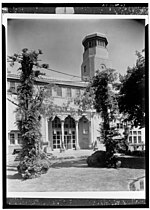Elmwood (Oyster Bay, New York)
Elmwood, also known as "The Cliffs," is a historic home located at Oyster Bay in Nassau County, New York. It was built in 1836 for New York merchant Thomas F. Youngs (1805–1883) in the Greek Revival style. The original house is a 2-story, gable-roofed, five-by-three-bay wood-frame house. It was expanded about 1915 during its ownership by Charles L. Tiffany II (1878–1947), son of Louis Comfort Tiffany (1848–1933), and his wife, the suffragist and philanthropist, Katrina Brandes Ely Tiffany (1875-1927). It features a prominent cornice and architrave and an imposing tetrastyle Ionic order portico. Also on the property are an assortment of 19th century dependencies including a gazebo, tool shed, ice house, greenhouse, barns, and a brick coach house built in 1918 by Mr. Tiffany. The property also features a tall, octagonal, board and batten water tower.It was listed on the National Register of Historic Places in 1975.
Excerpt from the Wikipedia article Elmwood (Oyster Bay, New York) (License: CC BY-SA 3.0, Authors).Elmwood (Oyster Bay, New York)
Town of Oyster Bay
Geographical coordinates (GPS) Address Nearby Places Show on map
Geographical coordinates (GPS)
| Latitude | Longitude |
|---|---|
| N 40.866388888889 ° | E -73.495833333333 ° |
Address
11771 Town of Oyster Bay
New York, United States
Open on Google Maps






